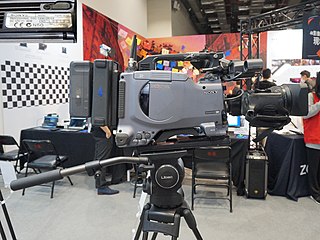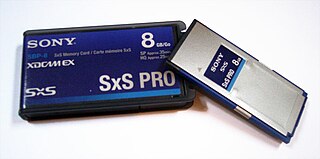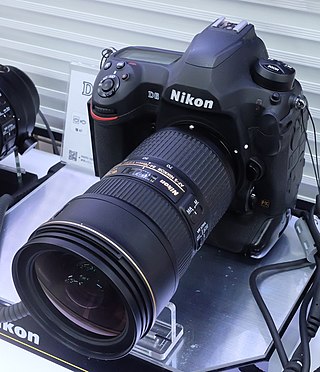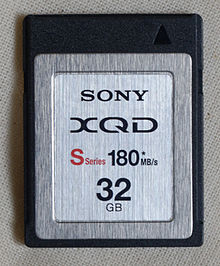
A digital camera is a camera that captures photographs in digital memory. Most cameras produced today are digital, largely replacing those that capture images on photographic film. Digital cameras are now widely incorporated into mobile devices like smartphones with the same or more capabilities and features of dedicated cameras. High-end, high-definition dedicated cameras are still commonly used by professionals and those who desire to take higher-quality photographs.

The Memory Stick is a removable flash memory card format, originally launched by Sony in late 1998. In addition to the original Memory Stick, this family includes the Memory Stick PRO, a revision that allows greater maximum storage capacity and faster file transfer speeds; Memory Stick Duo, a small-form-factor version of the Memory Stick ; the even smaller Memory Stick Micro (M2), and the Memory Stick PRO-HG, a high speed variant of the PRO to be used in high-definition video and still cameras.

A memory card is an electronic data storage device used for storing digital information, typically using flash memory. These are commonly used in digital portable electronic devices. They allow adding memory to such devices using a card in a socket instead of protruding USB flash drives.

CompactFlash (CF) is a flash memory mass storage device used mainly in portable electronic devices. The format was specified and the devices were first manufactured by SanDisk in 1994.

Secure Digital, officially abbreviated as SD, is a proprietary, non-volatile, flash memory card format the SD Association (SDA) developed for use in portable devices.

A flash drive is a portable computer drive that uses flash memory. Flash drives are the larger memory modules consisting of a number of flash chips. A flash chip is used to read the contents of a single cell, but it can write entire block of cells. They connect to a USB port and function as a folder.

The xD-Picture Card is an obsolete form of flash memory card, used in digital cameras made by Olympus, Fujifilm, and Kodak during the 2000s. The xD in the xD-Picture Card stands for eXtreme Digital.

XDCAM is a series of products for digital recording using random access solid-state memory media, introduced by Sony in 2003. Four different product lines – the XDCAM SD, XDCAM HD, XDCAM EX and XDCAM HD422 – differ in types of encoder used, frame size, container type and in recording media.

Lexar International is a brand of flash memory products manufactured by the Chinese memory company Longsys.
This table provides summary of comparison of various flash memory cards, as of 2017.
AVCHD is a file-based format for the digital recording and playback of high-definition video. It is H.264 and Dolby AC-3 packaged into the MPEG transport stream, with a set of constraints designed around the camcorders.

SxS (S-by-S) is a flash memory standard compliant to the Sony and SanDisk-created ExpressCard standard. According to Sandisk and Sony, the cards have transfer rates of 800 Mbit/s and burst transfer rate of up to 2.5 Gbit/s over the ExpressCard's PCI Express interface. Sony uses these cards as the storage medium for their XDCAM EX line of professional video cameras.

The Nikon D300 is a 12.3-megapixel semi-professional DX format digital single-lens reflex camera that Nikon Corporation announced on 23 August 2007 along with the Nikon D3 FX format camera. The D300 was discontinued by Nikon on September 11, 2009, being replaced by the modified Nikon D300S, which was released July 30, 2009. The D300S remained the premier Nikon DX camera until the D7100 was released in early 2013.
The SD Association (SDA) is an American nonprofit organization that sets standards for the SD memory card format. SanDisk, Panasonic (Matsushita), and Toshiba formed the SD Association in January 2000. In 2010, the SDA had approximately 1,000 member companies involved in the design and development of SD standards. Thousands of device models and hundreds of products across dozens of product categories integrate the small, removable memory cards.
Gruvi was a short-lived memory card format compatible with microSD developed by Sandisk in 2006. It used the company's TrustedFlash card technology, which functioned like the conventional SD card but it could be extended to on-demand content. The cards were intended for the distribution of music and videos and had a variety of special Digital rights management features including the ability to pre-load content that could be 'unlocked' at a later date. The announced objective was the replacement of CDs, which was highlighted by the involvement of music publisher EMI when the product was launched. The little cards featured a picture of the artist whose music was pre-loaded. They were compatible with mobile phones, tablets, and laptop computers. Only a handful of Gruvi cards were ever released, one of them was the album A Bigger Bang by the Rolling Stones.

The Nikon D300S is a 12.3-megapixel DX format digital single-lens reflex camera (DSLR) announced by Nikon on 30 July 2009. It replaced the D300 as Nikon's flagship DX format DSLR adding HD video recording. It has some similarities to the Nikon D700, with the same resolution, but has a smaller, higher-density sensor. The D300s was superseded by the Nikon D500, announced on January 5, 2016.

The Nikon D4 is a 16.2-megapixel professional-grade full frame (35mm) digital single-lens reflex camera (DSLR) announced by Nikon Corporation on 6 January 2012. It succeeds the Nikon D3S and introduces a number of improvements including a 16.2 megapixel sensor, improved auto-focus and metering sensors and the ability to shoot at an extended ISO speed of 204,800. The camera was released in February 2012 at a recommended retail price of $5999.95. It is the first camera to use the new XQD memory cards. It was replaced by the Nikon D4S as Nikon's flagship camera.

The Nikon D500 was a 20.9-megapixel professional digital single-lens reflex camera with an APS-C sensor. It was announced by Nikon Corporation on January 6, 2016 along with the Nikon D5 full frame camera. D500 replaced the D300S as Nikon's DX format flagship DSLR. On February 23, 2017, at CP+ show, a special edition was released for Nikon's 100th anniversary. The D500 jointly won a Camera Grand Prix Japan 2017 Editors Award. The camera was discontinued on February 1, 2022.

CFexpress is a standard for removable media cards proposed by the CompactFlash Association (CFA). The standard uses the NVM Express protocol over an PCIe 3.0 interface with 1 to 4 lanes where 1 GB/s data can be provided per lane. There are multiple form factors that feature different PCIe lane counts. One of the goals is to unify the ecosystem of removable storage by being compatible with standards already widely adopted, such as PCIe and NVMe. There already is a wide range of controllers, software and devices that uses these standards, accelerating adoption.

The Nikon D6 is a full frame professional DSLR camera announced by Nikon Corporation on February 11, 2020, to succeed the D5 as its flagship DSLR. It has a resolution of 20.8MP, like the D5. The D6 has a newer Expeed 6 processor that supports burst shooting at up to 14fps. It has 105 cross type focus points.


















